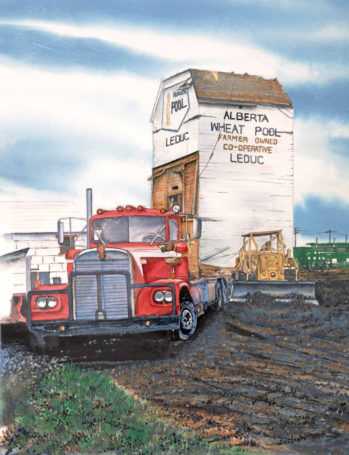February 6, 2020
Museum keeps historic grain elevator in Leduc
There was a time when buildings like the crib-style grain elevator in Leduc were the defining structures of small-town Alberta. Sentinels in the vast prairie landscape, they dwarfed all other important buildings of the time — the town hall, courthouse, local hotel and saloon.
They were as ubiquitous as the patches of wild rose along the highways. Though there is only one grain elevator left in Leduc, now a museum known as the Leduc Heritage Grain Elevator, one mustn’t forget how it and other grain elevators shaped Alberta.
Throughout the 20th Century, grain elevators played a major role in the province’s economic development. As railroads began to criss-cross the landscape, grain elevators sprouted up every eight to 15 kilometres. At that distance, farmers could handle the return trip in a day using their horsepulled wagons. Some of these grain elevators were located in established towns, but in many cases, towns sprung up around them.
Grain elevators were active commercial hubs. Crops were trucked in (or, in the early days, brought in by horse-drawn wagons) and tested for variables such as quality, weight and moisture content. A price would be quoted based on these factors as well as what the grain and futures markets dictated.

Farmers would then drop their grain into a pit, where a long, continuously looping belt with large cups called a leg would scoop it up and elevate it — hence the name “grain elevator” — to the selected bin.
Farmers took their payment and injected it into the local economy, shopping for groceries, clothing, furniture and whatever else their families might need. But grain elevators didn’t just boost the economy.
“Elevators were also social hubs where they drank coffee, played crib, solved world problems,” says Kerry Atkinson, museum coordinator for Alberta Legacy Development Society. “If you wanted to know what your neighbours three miles down the road were doing, you came here.”
Constructed in 1978 in the typical crib-style, with a gable roof and matching gable-roofed cupola, the Leduc elevator was one of the last built in the province. Crib-style construction featured outside walls made of interlocking pieces of wood, usually two-by-twos. This style allowed for quick construction while providing stable yet flexible walls.
No matter how sturdy these structures were, however, they couldn’t stand up to the rush of progress all around them. In the 1990s, the deregulation of Canada’s railways led to the closure of secondary railways across the province. At the same time, grain companies were consolidating operations in larger, more centralized terminals — simple concrete silos with little architectural appeal — on the outskirts of towns.
This combination of factors effectively put an end to the glory days of the grain elevator. Because grain companies didn’t want to pay taxes on the unused buildings, and many became the target of arsonists and vandals, thousands were demolished.
In Leduc in 2000, it looked as if their last remaining grain elevator would meet the same fate, until the Alberta Legacy Development Society took action. “After umpteen bake sales, book sales, garage sales, letter-writing, they were able to purchase the land from CP Rail and the building from Agricore,” recalls Atkinson. Agricore sold the building to the society for a dollar.
Once they owned the building, the society knew they would need help to maintain and develop it as a museum and interpretive centre. They established a fund at Edmonton Community Foundation. “The
fund is an investment for us and the interest that comes from that helps sustain us in our day-to-day operations as well as our future plans,” says Atkinson.
Those plans include the expansion of an educational program so students can learn about the importance of grain elevators to Alberta’s history. The society also wants to augment the museum with updated displays, including parking an old grain truck inside the elevator.
The Leduc Grain Elevator Interpretive Centre is open for tours, Tuesday through Saturday, 10 a.m. to 4 p.m. There is no fee to participate in a tour, but there is a donation box available.